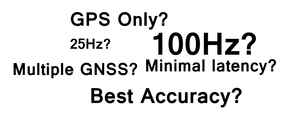
How to choose the best GPS for my application?
GPS System and GPS antenna
I can argue that the GPS system is the most complicated and most difficult system in a modern race car, especially in a racing motorcycle. It is amazing that it even works and how good modern GPS receivers are. Yet it is a common complain that the simple GPS doesn't work, lap times are not correct. Before starting arguing with me, consider this:
Signal level:
Imagine that there is a 30W lamp, 22000kms away and the GPS antenna needs to "see" that when the bike is leaning 50deg to the other direction. It is not an easy feat.
This signal level is about -125dBm and is below the thermal noise level. GPS antenna needs to be able to pick it, amplify the exact frequency only and minimize the noise while doing that.
Signal Timing:
GPS works by measuring the time it takes for the signal from the satellites to reach the GPS receiver.
Per the standard, normal GPS system operations must ensure the UTC offset data broadcast by GPS is within 40 nanoseconds to UTC, that is 0.000000004s.
Reflections and multi-path:
Then there are reflections, typically from buildings, trees. In motorcycle racing reflections can come from the riders back, windshield.
Multi-path reflection is a case where a duplicate signal that is created by reflection. This signal is little bit delayed compared to the original, real and original signal. GPS receiver then needs to decide which one is the correct one. Not easy.
Athmospheric disturbance:
Weather, sun etc... will also affect the accuracy of the GPS. Modern SBAS corrections can eliminate this error. This correction is applied when you see GPS Fix Type 2, Differential GPS. Fix type 1 is normal GPS without this correction.
Antenna installation:
This is the most important thing, think the antenna as the "eyes" of the GPS receiver and need to see the 30W lamp from 20000kms away. Chances are that the receiver can't receive the satellite if the antenna is blocked by some obstacle, rider, bike next to it, building etc...
I have seen very poor antenna installations, worst one was that the antenna was inside the seat unit, zip tied to the bottom of the sub frame. No wonder why the GPS reception was bad...
Basic instructions for antenna install:
- Always install it so that it has clear 360 view to the sky
- Ground plane is needed for the antenna. 70mm metal, round plate or aluminum tape under the fairing. Ground plane is not needed if installed on the top of the carbon fiber.
Motorcycles and to reduce the high lean angle problems:
- Install on the side that stays upright most of the time.
- Install to the highest and narrowest location.
Choosing the right GPS for your application might sound simple, just choose the one with the fastest output rate. Unfortunately, it is not so simple and is actually quite complicated. In this article we'll try to guide you to select best one for your use case.
When choosing the right GPS, environment where it is used is actually the most important criteria. 100Hz GPS is the right choice ONLY when there are no obstacles like trees, buildings or large hills. 100Hz is not the right choice for rally, hillclimb or any other racing when used in poor coverage and obstacles. Reason for this is that the amount of accumulated data is small from which the solution (Speed, position etc...) is calculated. All buildings, trees and other obstacles will show in the data as a large drops or spikes in the data. Surely, data could be averaged but then the advantage of the fast GPS is lost. Also, signal has to be strong, above 40dBi for the 100Hz device to work well.
Below is an example to illustrate the difference between 10Hz, 20Hz and 50Hz speed outputs. Test route is next to tall buildings.
Cursor location has a sudden spike in the 50Hz GPS speed output and is an area with houses next to the road. Outputs from 10 or 20Hz devices do not have these spikes because it has more data from longer period to calculate and average the speed.

These drops or spikes in speed make comparing laps very difficult and data is almost unusable.
To illustrate this further, below is a test with 10Hz, 20Hz and 50Hz GPS's measured during the same test route. Yellow, 50Hz has spikes and in general is noisier than others due to smaller amount of accumulated data.

So, how to select the GPS?
Use following guideline to select your device:
| 25Hz | 100Hz | |
|
Environment has trees buildings and other obstacles |
Best Serial: GPSL25 CAN: GPSCAN SA
|
Poor |
|
Stable speed output is desired |
Best Serial: GPSL25 CAN: GPSCAN SA |
Poor |
|
Fast performance with low latency is required and used in open sky. |
Best Serial: GPSL25 CAN: GPSCAN SA |
Best Serial: GPSL100 100Hz CAN: GPSCAN 100Hz |
|
Motorcycle racing application with high lean angles |
Best |
Poor |
ROC - Rate Of Change
To better illustrate the earlier point, a value called Rate Of Change - ROC. It measures the difference between the earlier and current measurement. Below are compared 2 receivers GPS1 is 25Hz (Red), GPS2 is 100Hz (Orange). Same driving route is used and measured at the same time using GPSCAN.

As you can see, difference is significant and 20Hz GPS1 is very stable.
Speed latency
If you need fast performance for launch control, 100Hz can't be beaten. But, 20Hz isn't much slower and might be actually the better choice considering all factors.

Contact US if you have comments or questions about choosing the right GPS.


